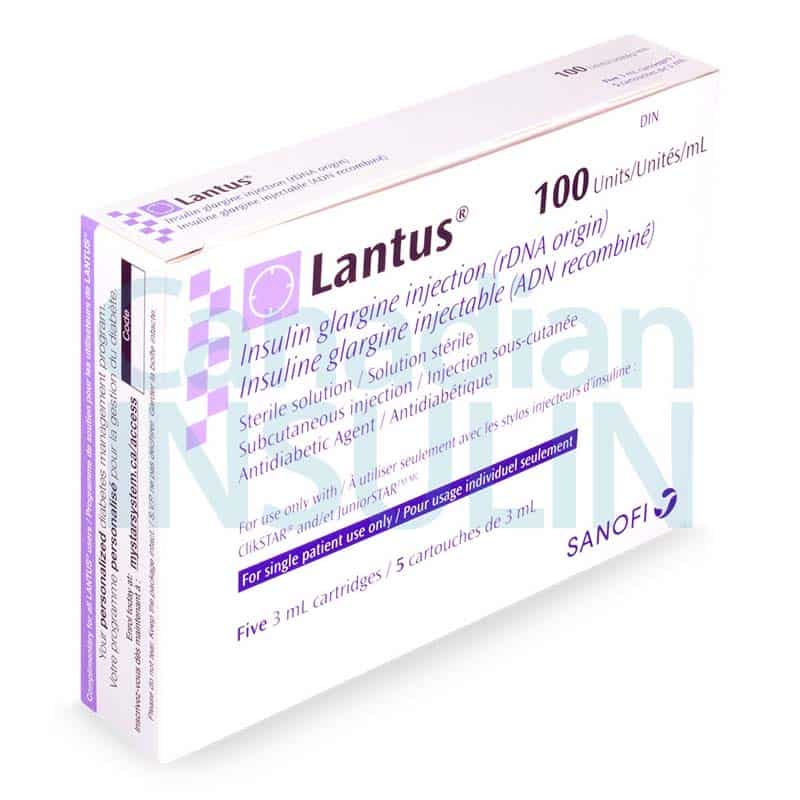Lantus Cartridges (100 Units/mL)
$128.92 – $503.36
Description
Lantus cartridges are only suitable for injecting just under the skin using a reusable pen. Speak to your doctor if you need to inject your insulin by another method.
Insulin glargine controls high blood glucose levels for adults and children over the age of 6 with type 1 and type 2 diabetes.
This medication is long-acting insulin that is similar to the insulin produced by the pancreas in our body. It begins working several hours after injection and continues to work evenly for 24 hours.
Lantus cartridges are made specifically to connect with certain insulin pens (including Lantus Solostar Pens)
This insulin may be recommended to be combined with oral diabetes medication or fast-acting insulin.
Taking insulin should only be part of your treatment. Patients should also incorporate a lifestyle that includes a healthy diet and regular exercise.
Warnings and Precautions
Talk to your doctor, pharmacist, or nurse before using Lantus. Follow the instructions closely for posology, monitoring (blood and urine tests), diet, and physical activity (physical work and exercise) as discussed with your doctor.
If your blood sugar is too low (hypoglycemia), follow the guidance for hypoglycemia.
The injection site should be rotated to prevent skin changes such as lumps under the skin. The insulin may not work very well if you inject it into a lumpy area (see usage tab). Contact your doctor if you are currently injecting into a lumpy area before injecting in a different location. Your doctor may tell you to check your blood sugar more closely and adjust your insulin or other anti-diabetic- medication doses.
Before traveling, consult your doctor. You may need to talk about the availability of your insulin in the country you are visiting and the supplies of insulin and needles. You may also need to discuss the correct storage of insulin, timing of administrations, and the effects of different time zones. It is also essential to go over possible new health risks in visiting countries and what you should do in emergencies.
If you experience any signs of hyperglycemia or hypoglycemia, managing your diabetes may require a lot of care (for example, adjustment to insulin dose, blood and urine tests). In most cases, you will need a doctor.
If you have type 1 diabetes (insulin-dependent diabetes mellitus), do not stop your insulin and continue to get enough carbohydrates. Always tell people who are caring for you or treating you that you require insulin.
Insulin treatment can cause the body to produce antibodies to insulin (substances that act against insulin). However, only very rarely will this require a change to your insulin dose.
Some patients with long-standing type 2 diabetes mellitus and heart disease or previous stroke who were treated with pioglitazone (oral anti-diabetic medicine used to treat type 2 diabetes mellitus) and insulin experienced the development of heart failure. Inform your doctor as soon as possible if you experience signs of heart failure such as unusual shortness of breath or rapid increase in weight, or localized swelling (edema).
Usage
Before starting your Lantus insulin treatment, inform your doctor of your existing medical conditions, especially heart, liver, or kidney problems.
Inform your doctor if you are pregnant, planning on pregnancy, breastfeeding, or planning to breastfeed. See the pregnancy tab for more information.
Keep your insulin schedule consistent. Lantus should be taken once daily at the same time.
Monitor your blood glucose levels while taking insulin.
Do not make any modifications to your insulin dose or schedule without consulting your doctor first.
Do not mix or dilute Lantus with other insulin or solutions. This may cause the insulin to not work as intended and affect blood glucose level control, leading to severe complications.
Only use Lantus if the solution is colorless or transparent, with no particles inside.
Check your insulin before taking it to make sure it’s the correct insulin.
Do not stop taking this medication unless instructed otherwise by your doctor.
Lantus is injected under the skin (subcutaneously). Your doctor will decide your dose and frequency based on your condition.
Side Effects
A side effect is an unwanted response to taking medication in regular dosages.
As with any medication, side effects may occur. They are usually temporary and go away within a few days or weeks.
Side effects when taking Lantus may include hypoglycemia (low blood sugar), severe allergic reactions (including body rash), painful swelling of the skin or mucous membranes.
Additional Information
| Lantus Cartridge - 100u/mL | 5 cartridges, 10 cartridges, 15 cartridges, 20 cartridges |
|---|


Reviews
There are no reviews yet.